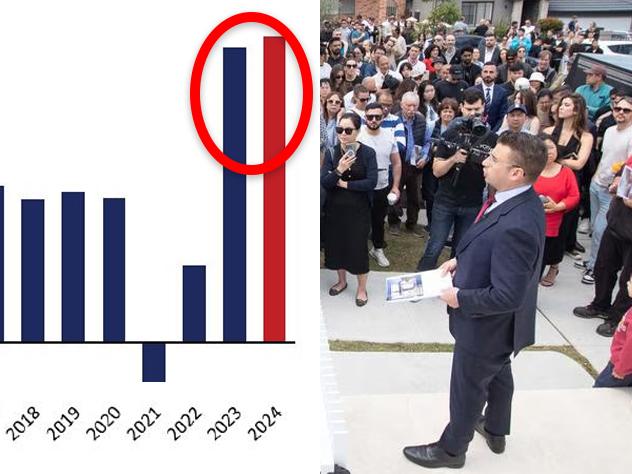Housing construction has been falling behind targets nationally.
Australia’s migration intake has exploded to double pre-pandemic levels, sparking fresh warnings it is driving up house prices and rents, straining services and deepening the nation’s economic squeeze.
New figures released by the Australian Bureau of Statistics showed there were 110,062 new arrivals over the March quarter – the equivalent of 1223 people every single day and almost 500,000 per year.
Migration accounted for three-quarters of population growth, the ABS figures revealed.
Intake over the March quarter was double the pre-pandemic quarterly average of 55,036 recorded from March 2010 to March 2020.
Critics warn the intake is overwhelming housing supply, worsening rental shortages and fuelling record property prices, while also placing unsustainable pressure on infrastructure and public services.
The Institute of Public Affairs claimed the surge, green-lit by the Albanese Government, had destroyed the dream of home ownership and left mainstream Australians “poorer”.
MORE: Shock figures today confirm next RBA call
Demand has been heating up, with a recent Sydney auction attracting a huge crowd.
The think tank’s deputy executive director Daniel Wild said migration had dropped below earlier peak levels but remained well above historic patterns and pre-pandemic volumes.
“The elevated level of migration is no longer a post-pandemic catch up,” he said.
“It’s the new normal under the Albanese government. It is something that Australia simply cannot afford – with housing, infrastructure, and services unable to keep up.”
Housing experts said the primary impact of migration on the housing market was on rents, but there was overflow into the buying market as well.
Latest SQM Research data indicated vacancy rates in most cities were near record lows of under one per cent, indicating a severe shortage of available homes.
MORE: Major bank slashes rates to lowest in years
Prime Minister Anthony Albanese has been criticised for the migration intake. Picture: Hilary Wardhaugh/Getty Images
These warnings have come as HIA figures showed the country has been falling behind in critical targets set out in the National Housing Accord plan to build 1.2 million new homes by 2030.
HIA managing director Jocelyn Martin said in July, on the anniversary of the National Housing Accord, that the pace of building needed to speed up to meet targets and accommodate population growth.
“There were only 168,050 dwelling commencements nationally in the 2024 calendar year. If we continue at this pace, Australia will fall well short of the 1.2 million homes target.
“HIA’s forecast of dwelling commencements, or gross new housing supply, shows only around 986,000 homes will be delivered to market over the five years to 2028/29.”
Institute of Public Affairs’ Daniel Wild. Picture: NewsWire/ Richard Gosling
Ms Martin added that building industry problems have exacerbated the challenges.
“Builders are still facing the same barriers that have been holding the industry back for years,” she said.
“Land supply remains constrained, planning systems are slow and complex, and the cost of delivering a new home continues to rise because of charges, taxes and red tape. Interest rates, skill shortages and material costs only add to these pressures.
The ABS data confirms net overseas migration is running at twice the pre-Covid quarterly average of 55,000, raising fears that the government’s promises to rein in population growth have failed.
Mr Wild said the government’s “deliberate” migration strategy had contributed to a prolonged per-capita recession and urged a “harder and faster” cut to the intake.
“Australia is a tolerant and welcoming country, and migration has and will always be a part of our national story. But Australia’s migration program needs to be properly planned for, sustainable, and have the support of the community,” Mr Wild said.
HIA figures have revealed building is not occurring fast enough to contain population growth.
Migration has emerged as a hot-button issue in recent months.
Thousands of protesters from across the political spectrum converged on Australia’s capital cities and regional centres last Saturday, marching through the streets and facing off with police.
Opposing groups came face-to-face in multiple cities, as rallies against racism and mass migration unfolded.
The migration boom comes as first-home buyers face the toughest affordability crisis in a generation, with property prices in Sydney, Brisbane and Melbourne climbing back near record highs.
These price increases – fuelled by multiple forces – have often eclipsed the savings buyers would have got from recent cuts in interest rates.
“Mainstream Australians are paying the price,” Mr Wild said.
Abul Rizvi, former deputy secretary in the immigration department and ANU professor Alan Gamlen told media the most relevant figure for assessing the impact on housing and services was net overseas migration.
Federal government figures showed net overseas migration for over 2024 was 341,000 people, down 37 per cent from a peak of 538,000 in 2022/23.

